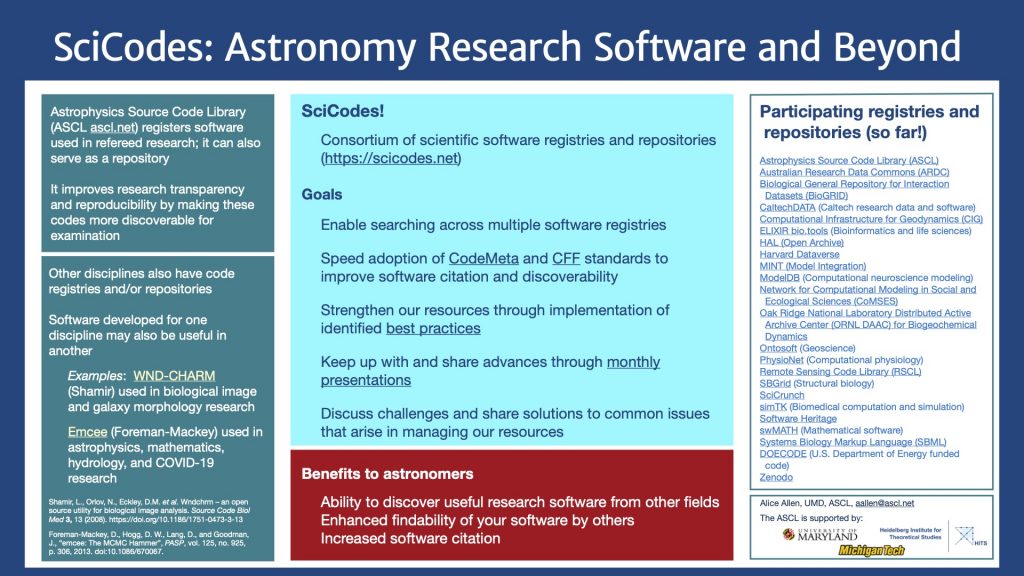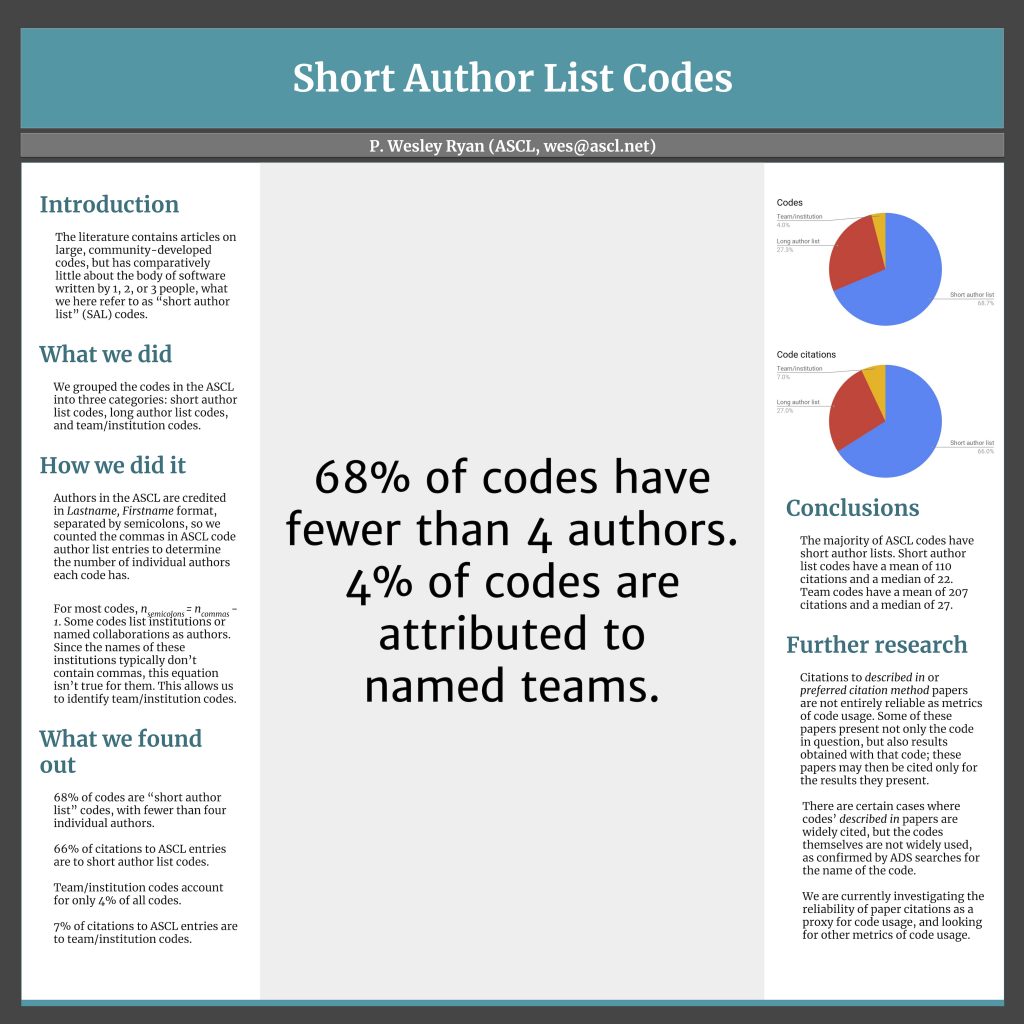The ADASS conference took place this week. The ASCL presented a poster about SciCodes at the conference. Though ADASS took up most of my time, eight new code entries, three of them submitted by their authors, were assigned ASCL IDs and moved into production. I also wrote and submitted an abstract for an iPoster presentation at the AAS’s January 2022 meeting.
Category Archives: conferences
ASCL poster on SciCodes consortium at ADASS XXXI
The Astrophysics Source Code Library (ASCL ascl.net), started in 1999, is a free open registry of software used in refereed astronomy research. Over the past few years, it has spearheaded an effort to form a consortium of scientific software registries and repositories. In 2019 and 2020, ASCL contacted editors and maintainers of academic discipline and institutional software registries and repositories in math, biology, neuroscience, geophysics, remote sensing, and other fields to develop a list of best practices for research software registries and repositories. At the completion of that project, performed as a Task Force for a FORCE11 working group, members decided to form SciCodes as an ongoing consortium. This poster will cover the consortium’s work so far, what it is currently working on, what it hopes to achieve for making scientific research software more discoverable across disciplines, and how the consortium can benefit astronomers.
Download poster (PDF)
#ADASSXXXI
Resources for SIAM CSE21 presentation on Schrödinger’s Code
I am giving a presentation at the SIAM (virtual) Conference on Computational Science and Engineering today in a Minisymposium on Data-Driven Analysis of Scientific Software Quality, Availability, and Development Productivity to discuss research we published in 2018 and the relevance of our findings to scientific software availability. A link to the slides from the presentation is below, along with links to additional information.
Slides (PDF)
Paper: Schroedinger’s Code: A Preliminary Study on Research Source Code Availability and Link Persistence in Astrophysics
Data and code
Other studies mentioned:
Collberg C., Proebsting T. and Warren A. M. 2014 Repeatability and Benefaction in Computer Systems Research: A Study and a Modest Proposal, Tech. Rep. TR 14-04 (http://repeatability.cs.arizona.edu/v2/RepeatabilityTR.pdf)
Howison J. and Bullard J. 2016 Software in the scientific literature: Problems with seeing, finding, and using software mentioned in the biology literature, Journal of the Association for Information Science and Technology 67 2137
Mangul, S., Mosqueiro, T., Duong, D., Mitchell, K., Sarwal, V., Hill, B., Brito, J., Littman, R., Statz, B., Lam, A., Dayama, G., Grieneisen, L., Martin, L., Flint, J., Eskin, E., & Blekhman, R. 2018, A comprehensive analysis of the usability and archival stability of omics computational tools and resources, bioRxiv
Rewarding the effort involved
Funding
How to fund research software development
Essential Open Source Software for Science
DOE to Provide $12 Million for Research on Adapting Scientific Software to Run on Next-Generation Supercomputers
Recognition
Citations for software
FORCE11 Software Citation Principles
FORCE11 Software Citation Implementation Working Group
Software must be recognised as an important output of scholarly research
Career path
The Society of Research Software Engineering
US Research Software Engineer Association
Training
Better Scientific Software (BSSw)
SciCoder
Software Sustainability Institute
How to Professionally Develop Reusable Scientific Software—And When Not To
Changes in journal practices
In which journals should I publish my software?
Software with impact
An empirical analysis of journal policy effectiveness for computational reproducibility
Better support through technology
Tools for working with CITATION.cff files
Create a CodeMeta file
Getting a DOI for your code
The ASCL at the 237th meeting of the American Astronomical Society
It’s that time of year again, when astronomers’ hearts and wings turn to AAS for the winter AAS meeting. This year, however, the wings are virtual; like other conferences in this time of pandemic, the 237th meeting of the AAS is online. I’m very impressed with the online meeting space, which includes a conference center with different locations to visit, a virtual exhibit hall, an iPoster gallery, and many opportunities through Slack and thoughtfully-planned activities to enable and encourage interaction between attendees, exhibitors, and presenters, including the always great Open Mic event, a highlight of the winter meeting, on Wednesday evening.
Members of the ASCL are presenting two iPosters + (the “plus” is a short Zoom session about the poster) and an oral presentation at this meeting.
On Monday, Siddha Mavuram, an UMD student hired to do development work for the ASCL for our NASA ADAP project, is doing an iPoster + presentation titled Come search the ASCL with our new API! I also have an iPoster + presentation on Monday called Life, the Universe and Everything… you ever wanted to know about the Astrophysics Source Code Library. Though our short talks, using our posters only as our visual aids, are on Monday, our posters are available all week.
On Tuesday, Peter Teuben is presenting results of our NASA ADAP project. Though Siddha is presenting part of the development work done for this project, Peter is sharing the overall results in his oral presentation Increasing the visibility of NASA astrophysics software through the ASCL, showing how this project has made it possible to search the ASCL and ADS for NASA software through the use of keywords and, on ADS, the doctype value software. You can see these results yourself on the ASCL and with an ADS search.
Because I very cleverly failed to realize that all the links I added to the slides for my iPoster wouldn’t work once I made those slides images (doh!), I provide a PDF of these slides for download below in which most, but alas not all, of the links work. Later this week, I’ll provide a full list of links in another post that will contain all of the resources and links the ASCL is presenting this week.
Lightning talk at ADASS XXX: Making organizational software easier to find
The excellent ADASS XXX conference concluded yesterday. 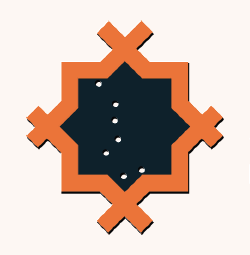 I missed meeting ADASS attendees face-to-face, but was delighted to spend time with them safely online, to learn about their projects and research, to talk about software and data, to share what the ASCL has been doing, and to meet old and new friends. The all-virtual conference was just about perfect; the technology set-up was excellent, providing opportunities to see sessions as they happened or at a later time on video, ask questions, comment on and discuss what was presented, and have one-on-one or small group video calls. The schedule was easy to keep track of, as one could subscribe to the schedule and get updates to it (mostly additions) immediately. Support was extremely responsive; an online Help Desk provided answers to queries almost immediately. There was even a conference photo!
I missed meeting ADASS attendees face-to-face, but was delighted to spend time with them safely online, to learn about their projects and research, to talk about software and data, to share what the ASCL has been doing, and to meet old and new friends. The all-virtual conference was just about perfect; the technology set-up was excellent, providing opportunities to see sessions as they happened or at a later time on video, ask questions, comment on and discuss what was presented, and have one-on-one or small group video calls. The schedule was easy to keep track of, as one could subscribe to the schedule and get updates to it (mostly additions) immediately. Support was extremely responsive; an online Help Desk provided answers to queries almost immediately. There was even a conference photo!

Poster presenters were invited to record and upload a lightning talk — no more than three minutes — for their posters; two-minute lightning talks via Zoom were also arranged at the conference. The ASCL presented a poster on Making organizational software easier to find in ASCL and ADS; the hastily-put-together lightning talk presented at the conference for this poster is below.
ADASS attendee Simón Torres offered to download all the pre-recorded lightning talks and stream them during the conference, so a Poster Video Watching Party was scheduled for Wednesday afternoon. The stream was great fun to watch! It was interesting, too, to see all the different ways people presented their lightning talks.
What a great conference this was! I look forward to next year’s!
ASCL poster on NASA software project at ADASS XXX
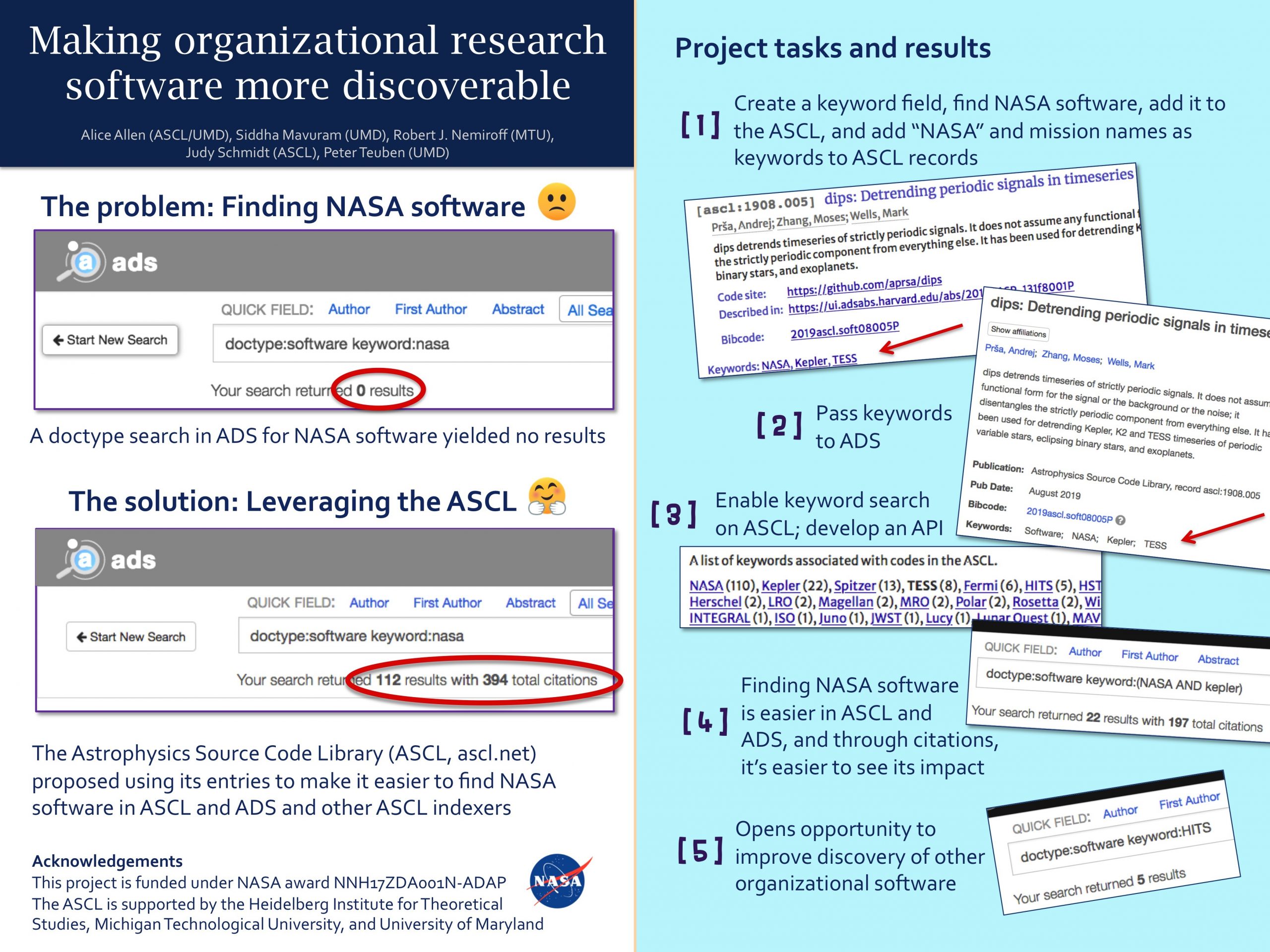
Software is the most used instrument in astronomy, and organizations such as NASA and the Heidelberg Institute for Theoretical Physics (HITS) fund, develop, and release research software. NASA, for example, has created sites such as code.nasa.gov and software.nasa.gov to share its software with the world, but how easy is it to see what NASA has? Until recently, searching NASA’s Astrophysics Data System (ADS) for NASA’s astronomy software has not been fruitful. Through its ADAP program, NASA has funded the Astrophysics Source Code Library (ASCL ascl.net) to improve the discoverability of these codes. Adding institutional tags to ASCL entries makes it easy to find this software not only in the ASCL but also in ADS and other services that index the ASCL. This poster presentation covers the changes the ASCL has made as a result of this funding and how you can use the results of this work to better find organizational software in ASCL and ADS.
ASCL API poster at ADASS XXX
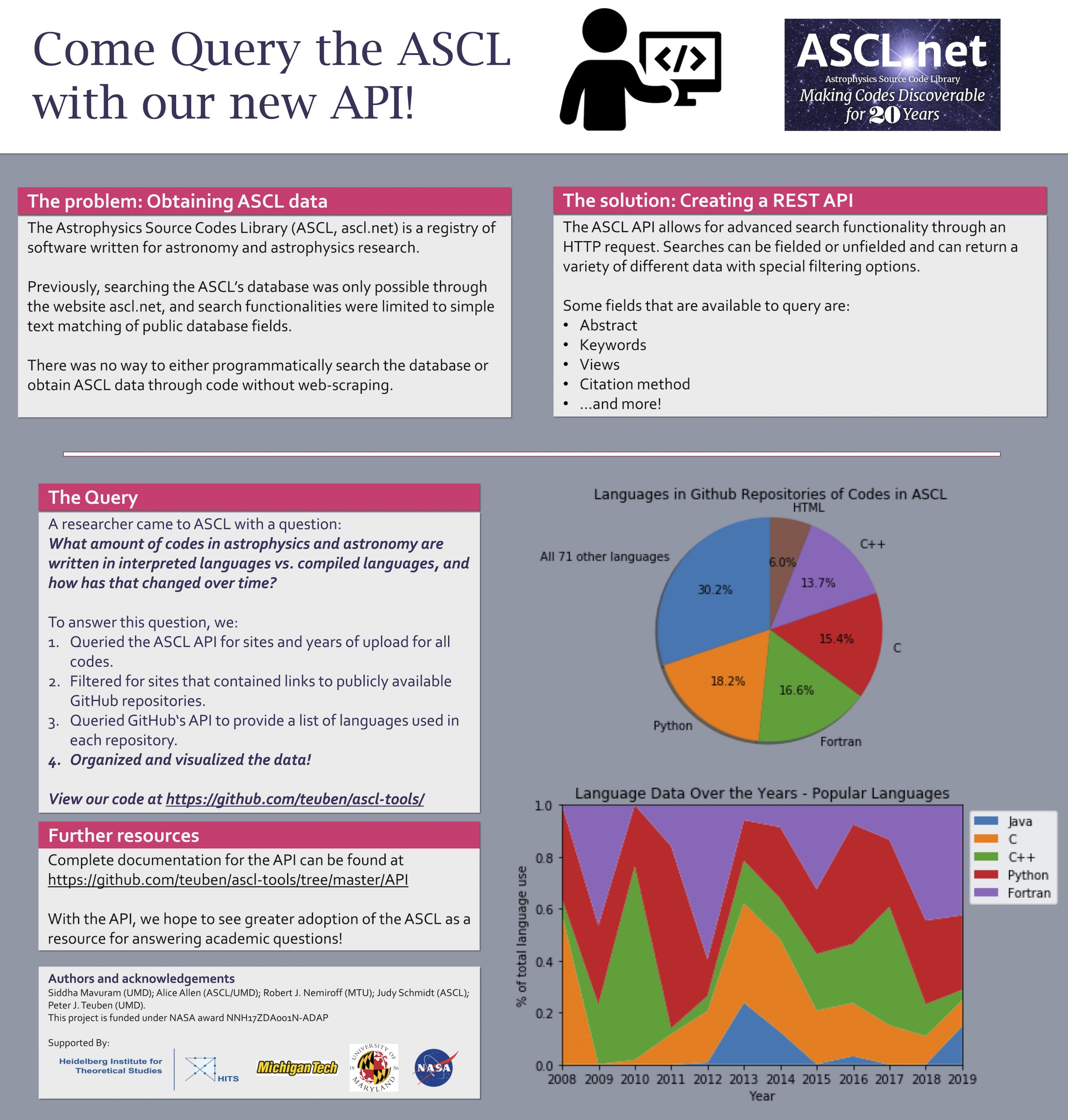
We have developed an API for the Astrophysics Source Code Library (ASCL) that enhances the ability of users to conduct complex and automated queries on ASCL indexed codes. The API is public and allows anyone to programmatically search and filter the ASCL software database via an HTTP request. For example, the search https://ascl.net/api/search/?q=%22supernova%22&fl=credit returns a list of authors with ASCL-indexed codes involving supernovae in JSON format. We will demonstrate the API and show its use in answering a researcher’s questions regarding the growth and usage of both interpreted and compiled languages in the database, gaining a more nuanced understanding of trends in astrophysics software development. Our findings confirmed a piece of conventional wisdom: that Python is growing in market share, while low level programming languages like C and C++ remain very popular. Further documentation for the API is available at https://github.com/teuben/ascl-tools/tree/master/API.
Siddha Mavuram (UMD), Alice Allen (ASCL/UMD), Robert J. Nemiroff (MTU), Judy Schmidt (ASCL), Peter J. Teuben (UMD)
ADASS 2020 in the time of pandemic
Astronomical Data Analysis Software and Systems (ADASS), which was to have been in Granada, Spain this year, kicked off the fully online ADASS X XX meeting yesterday with four tutorials, as is usually done, though not quite like it was done this year. The Programming Organizing Committee and especially the Local Organizing Committee had to convert a conference that had been two years in the planning to a virtual meeting. This offered numerous challenges and learning opportunities! One challenge is that the conference is international; scheduling sessions for access to all participants couldn’t have been easy, but with the technology stack they chose, which includes the conference website, Zoom, YouTube, and Discord, and hard work, all of ADASS’s resources are available to all participants. One might have to get up early or stay up late to hear all of the talks live — the sleep-deprived author of this post awoke at 12:15 AM today to catch the opening sessions — but there are asynchronous options available, so groggy stumbling as one makes her way to the computer is a choice, not a requirement.
XX meeting yesterday with four tutorials, as is usually done, though not quite like it was done this year. The Programming Organizing Committee and especially the Local Organizing Committee had to convert a conference that had been two years in the planning to a virtual meeting. This offered numerous challenges and learning opportunities! One challenge is that the conference is international; scheduling sessions for access to all participants couldn’t have been easy, but with the technology stack they chose, which includes the conference website, Zoom, YouTube, and Discord, and hard work, all of ADASS’s resources are available to all participants. One might have to get up early or stay up late to hear all of the talks live — the sleep-deprived author of this post awoke at 12:15 AM today to catch the opening sessions — but there are asynchronous options available, so groggy stumbling as one makes her way to the computer is a choice, not a requirement.
The ASCL has several presentations and activities this year. ASCL Chair Peter Teuben, ASCL Advisory Committee member Bruce Berriman, and I organized a Birds of a Feather (BoF) session on How to better describe software for discovery and citation today. We have organized BoFs focused on some aspect of software in the past, and, as in the past, this BoF offered a number of very short presentations and then open discussion.
The BoF session focused on software metadata, to improve how software is described and can be discovered and cited. After Teuben opened the session, Berriman presented his experience with using CiteAs to see how it suggested his software Montage be cited.  CiteAs uses numerous ways to find a code’s citation method, including looking for metadata files — specific files that contain metadata for the software — on the code’s website and/or GitHub repository. Montage does not currently have a metadata file on its sites, so the citation method CiteAs suggested was not as robust as it could have been. The results of the search and its provenance are shown in the BoF’s slides, which can be downloaded at a link below.
CiteAs uses numerous ways to find a code’s citation method, including looking for metadata files — specific files that contain metadata for the software — on the code’s website and/or GitHub repository. Montage does not currently have a metadata file on its sites, so the citation method CiteAs suggested was not as robust as it could have been. The results of the search and its provenance are shown in the BoF’s slides, which can be downloaded at a link below.
This led nicely into my short talk on metadata files and how the ASCL can create a metadata file from an ASCL entry. 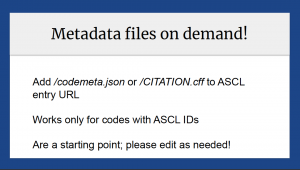 The files the ASCL creates programmatically, codemeta.json and CITATION.cff, are intended to be starting points and contain placeholders for data the ASCL does not capture, but which we feel should be included in the metadata file; we encourage software authors to edit these files before they are placed on one’s code site.
The files the ASCL creates programmatically, codemeta.json and CITATION.cff, are intended to be starting points and contain placeholders for data the ASCL does not capture, but which we feel should be included in the metadata file; we encourage software authors to edit these files before they are placed on one’s code site.
Yan Grange, who had organized an earlier BoF on Best licensing practices, presented a summary of the session and the results of two of the several polls taken during that BoF. 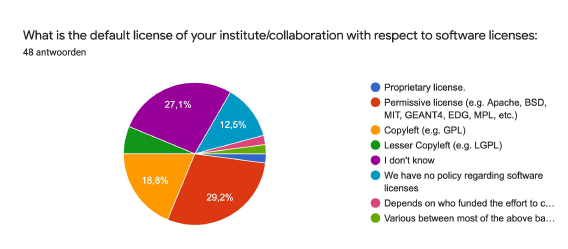 Providing a license for your software is vitally important, as it lets others know what they can and cannot do with your software. Resources and other information from the earlier BoF are available online, and Grange’s summary slides for our software metadata BoF are included in the slides file below.
Providing a license for your software is vitally important, as it lets others know what they can and cannot do with your software. Resources and other information from the earlier BoF are available online, and Grange’s summary slides for our software metadata BoF are included in the slides file below.
Teuben presented on several related topics: expanding or deepening a codemeta file with “API” information, the Unified Astronomy Thesaurus (UAT) and keywords, and the possibility of taking a software census at a niche science meeting. For this latter, he would like to take a well-defined field in astrophysics and have members of that community take an inventory of the software used and categorize it.  He thinks a conference would be an ideal event for getting all the stakeholders together, and has identified a possible candidate conference for this activity.
He thinks a conference would be an ideal event for getting all the stakeholders together, and has identified a possible candidate conference for this activity.
The floor, if there can be a floor in a virtual meeting, was then open for comments, questions, answers and ideas, though discussion had already started in the Discord channel. One outcome of this session was that before the end of it, several participants had added metadata files to code repositories!
All slides for this session are in the PDF file below. If you would like more information about the session, please let us know in the comments section below, pinging us at ADASS if you are participating in the meeting, or by emailing me at editor@ascl.net.
Slides (PDF)
The ASCL at AAS 235
The ASCL is participating in the American Astronomical Society (AAS) meeting that started yesterday in Honolulu, Hawai’i. We have two events, both on Sunday, January 5:
Best ways to let others know how to cite your research software
January 5; Poster 109.12
Software citation is good for research transparency and reproducibility, and maybe, if you work it right, for your CV, too. You can get credit and recognition through citations for your code! This presentation highlights several powerful methods for increasing the probability that use of your research software will be cited, and cited correctly. The presentation covers how to create codemeta.json and CITATION.cff automagically from Astrophysics Source Code Library (ASCL ascl.net) entries, edit, and use these files, the value of including such files on your code site(s), and efforts underway in astronomy and other fields to improve software citation and credit.
The Future and Future Governance of the Astrophysics Source Code Library
January 5, 2:00 PM – 3:30 PM; HCC – Room 301B
Over the past ten years, the Astrophysics Source Code Library (ASCL, ascl.net) has grown from a small repository holding about 40 codes with hand-coded HTML pages maintained by one person to a resource with citable entries on over 2000 codes with a modern database structure that is user- and editor-friendly maintained by a small group of volunteers. With its 20th anniversary now behind it, it’s time to look at the resource and its governance and management. Does its current structure best serve the astro community? What changes would you like to see to its governance? We don’t know the answers to these and other questions! Please join us for an open discussion on the resource and what a new governance model for the ASCL might be.
ASCL research poster at ADASS XXIX
This presentation covers research on software authorship and citation, which we carried out between July and September 2019. We examined codes authored by three or fewer people (“short author list” codes) and codes authored by institutional teams, to determine how many codes in the ASCL can be attributed to one of these categories. Utilizing ADS data, we measured the number of citations per authorship category. We carried out further research to determine whether we could infer software usage and code usage statistics from the number of citations to code description papers. Our research shows that citations to code description papers are not a reliable proxy for software usage.
P. Wesley Ryan, Astrophysics Source Code Library
Download poster (PDF)
